Collaborative Partnerships with Young Children and Their Families
Added on 2023-06-03
21 Pages5921 Words390 Views
Running head: WORKING IN COLLABORATIVE PARTNERSHIP 1
Collaborative Partnerships with Young Children and Their Families
Name
Institution
Collaborative Partnerships with Young Children and Their Families
Name
Institution
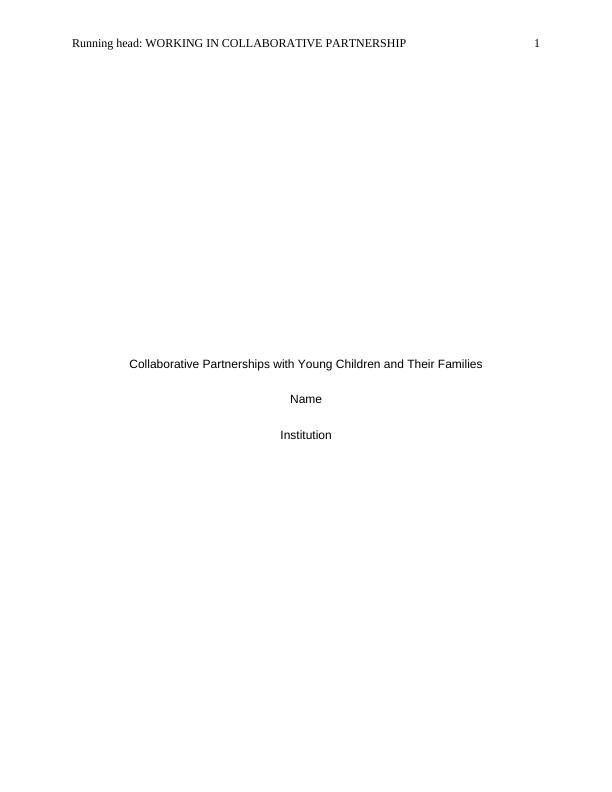
WORKING IN COLLABORATIVE PARTNERSHIP 2
Collaborative Partnerships with Young Children and Their Families
Collaboration entails a mutually well-defined and beneficial relationship between
two or more organizations with the commitment of setting common goals, developing a
joint structure, mutual authority, shared responsibility and accountability (Davies, 2005).
The relationship is maintained based on trust and shared a vision with the potential to
enhance both parties’ ability to attain better qualitative outcomes. In New Zealand, early
childhood education and care play a significant role in shaping long-term outcomes and
benefits for children (Boylan & Dalrymple, 2009). One of the major determinants of
quality childhood program is the quality collaborative partnership that educators develop
families, parents as partners who are equal in the care and education of young children.
This paper analyses the significance and effects of working in collaborative partnerships
with young children and their families, utilizing a range of academic and research-based
literature.
Significances
Benefits to Children
As argued by Davies (2005), young children benefit when the adults who take
care of them work collaboratively. The collaborative partnership allows the staff and
families to share discussions on how they can meet the needs of children. Families are
aware of the behaviors, moods, personality, and strengths of their children. The staff
can also learn about the child much more via their daily experiences and hence can
share their comprehension on children development. Through a collaborative
Collaborative Partnerships with Young Children and Their Families
Collaboration entails a mutually well-defined and beneficial relationship between
two or more organizations with the commitment of setting common goals, developing a
joint structure, mutual authority, shared responsibility and accountability (Davies, 2005).
The relationship is maintained based on trust and shared a vision with the potential to
enhance both parties’ ability to attain better qualitative outcomes. In New Zealand, early
childhood education and care play a significant role in shaping long-term outcomes and
benefits for children (Boylan & Dalrymple, 2009). One of the major determinants of
quality childhood program is the quality collaborative partnership that educators develop
families, parents as partners who are equal in the care and education of young children.
This paper analyses the significance and effects of working in collaborative partnerships
with young children and their families, utilizing a range of academic and research-based
literature.
Significances
Benefits to Children
As argued by Davies (2005), young children benefit when the adults who take
care of them work collaboratively. The collaborative partnership allows the staff and
families to share discussions on how they can meet the needs of children. Families are
aware of the behaviors, moods, personality, and strengths of their children. The staff
can also learn about the child much more via their daily experiences and hence can
share their comprehension on children development. Through a collaborative
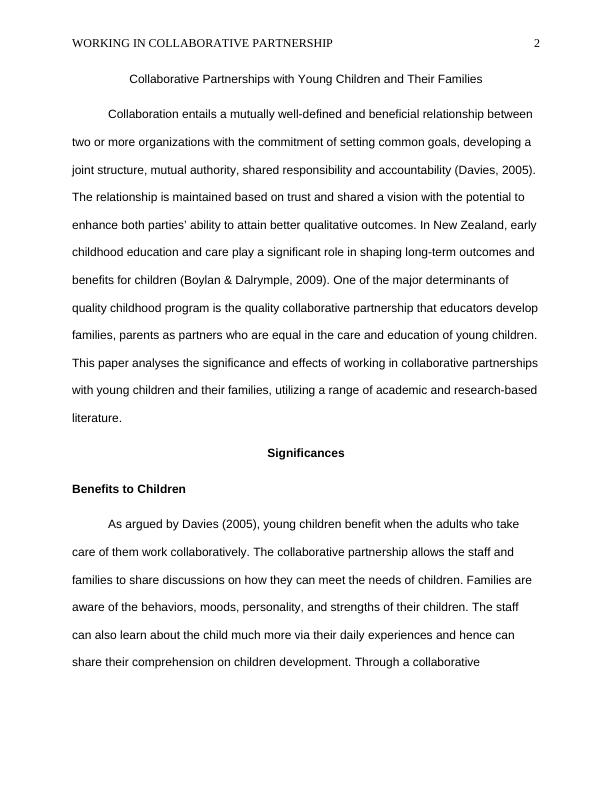
WORKING IN COLLABORATIVE PARTNERSHIP 3
partnership, the staff and families can exchange information and focus on meeting the
needs of each child as well as support their development (May 2013).
The collaborative partnership provides children with the opportunity to see
significant people working together in their lives. Once children see positive
communication among their parents and staff or carer, they start learning how vital it is
to build healthy correlations (Davies, 2005). For instance, when children see parents
and carers are communicating well by being friendly with the staff, they begin to learn
that this how people relate (Peyton, 2017). Children can feel safe and trust the staff who
are supported and respected by their family and who support and respect their family in
return. Children at their service of early childhood and positive experiences experience
comfortability. Children feel important and valued when the staff and families respect
and support each other as well as take interest in their lives. Carers and parents can
also help difficulties of mental health when they when they work in collaborative
partnership (Wilder, 2013).
Working in collaborative partnership allows the staff and families to share their
experiences and understanding of how bonding is significant to children (Davies, 2005).
Young children are still developing and have trouble when they are separated from one
environment to another one. Working in partnership with staff and families can enable
children to negotiate the differences between settings like home and service of early
childhood by seeing the adults who take care of them working collaboratively (Sclafani,
2018).
Parents’ involvement in the schooling of children helps to create an ample
environment for children. Parents are more able to structure their experiences for
partnership, the staff and families can exchange information and focus on meeting the
needs of each child as well as support their development (May 2013).
The collaborative partnership provides children with the opportunity to see
significant people working together in their lives. Once children see positive
communication among their parents and staff or carer, they start learning how vital it is
to build healthy correlations (Davies, 2005). For instance, when children see parents
and carers are communicating well by being friendly with the staff, they begin to learn
that this how people relate (Peyton, 2017). Children can feel safe and trust the staff who
are supported and respected by their family and who support and respect their family in
return. Children at their service of early childhood and positive experiences experience
comfortability. Children feel important and valued when the staff and families respect
and support each other as well as take interest in their lives. Carers and parents can
also help difficulties of mental health when they when they work in collaborative
partnership (Wilder, 2013).
Working in collaborative partnership allows the staff and families to share their
experiences and understanding of how bonding is significant to children (Davies, 2005).
Young children are still developing and have trouble when they are separated from one
environment to another one. Working in partnership with staff and families can enable
children to negotiate the differences between settings like home and service of early
childhood by seeing the adults who take care of them working collaboratively (Sclafani,
2018).
Parents’ involvement in the schooling of children helps to create an ample
environment for children. Parents are more able to structure their experiences for
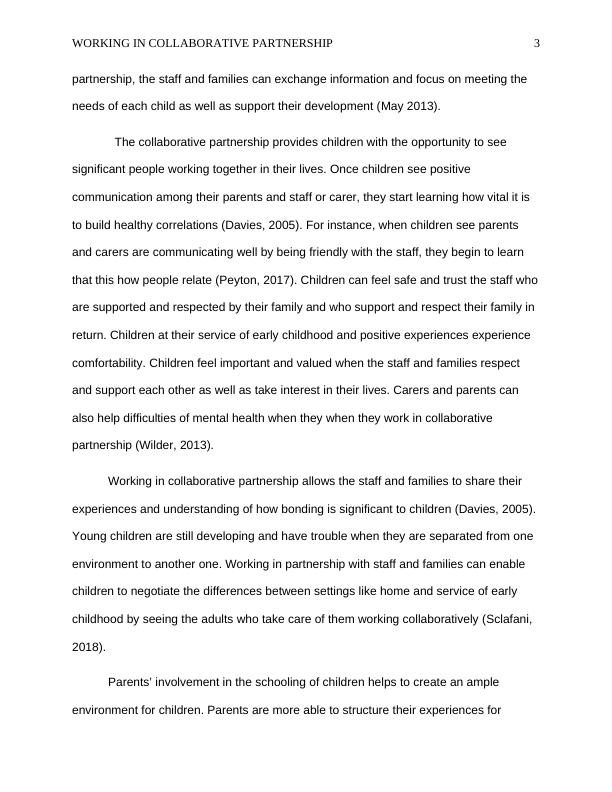
WORKING IN COLLABORATIVE PARTNERSHIP 4
children that promotes the development of skills enhance the sense of competence and
achievement for the children (Wilder, 2013). A strong indication has been shown when
parents get involved in the schooling of their children which to a positive impact on the
achievements of academic, especially in numeracy and literacy (Wilder, 2013). It has
been found that the involvement of parents promotes the positive impact on children’
behavior while in class, attendances, schooling attitude and retention. Children whose
parents are involved in their schooling have shown to have higher self-confidence in
academic learning and ability as well as strong extrinsic and intrinsic motivation by
(Masten & Monn, 2015). Parents help their children to enhance their competence
perceptions and empower children to control learning on their own. It has been found
that when children observe the mutual respect and interactions among adults, it helps
them comprehend, develop dispositions that are more positive and make them feel
comfortable while in school (Erwin et al, 2015).
Collaborative partnership improves the outcomes of children. Stonehouse (2011)
found that the participation of parents in the learning of their children, results in
intellectual gains, especially in centers where parent engagement is highly encouraged.
Research has shown that settings that most effective are those that share information
that is child-related between the parents, Whanau and the staff (Wilder, 2013). These
settings also had parents involved often in the decision-making process of the learning
program of their children. Collaborative partnership with young children and their
families leads to the establishment of shared aims, which contributes to the children’s
better outcome despite the quality of the children’s’ center (Peyton, 2017).
Benefits to families
children that promotes the development of skills enhance the sense of competence and
achievement for the children (Wilder, 2013). A strong indication has been shown when
parents get involved in the schooling of their children which to a positive impact on the
achievements of academic, especially in numeracy and literacy (Wilder, 2013). It has
been found that the involvement of parents promotes the positive impact on children’
behavior while in class, attendances, schooling attitude and retention. Children whose
parents are involved in their schooling have shown to have higher self-confidence in
academic learning and ability as well as strong extrinsic and intrinsic motivation by
(Masten & Monn, 2015). Parents help their children to enhance their competence
perceptions and empower children to control learning on their own. It has been found
that when children observe the mutual respect and interactions among adults, it helps
them comprehend, develop dispositions that are more positive and make them feel
comfortable while in school (Erwin et al, 2015).
Collaborative partnership improves the outcomes of children. Stonehouse (2011)
found that the participation of parents in the learning of their children, results in
intellectual gains, especially in centers where parent engagement is highly encouraged.
Research has shown that settings that most effective are those that share information
that is child-related between the parents, Whanau and the staff (Wilder, 2013). These
settings also had parents involved often in the decision-making process of the learning
program of their children. Collaborative partnership with young children and their
families leads to the establishment of shared aims, which contributes to the children’s
better outcome despite the quality of the children’s’ center (Peyton, 2017).
Benefits to families

WORKING IN COLLABORATIVE PARTNERSHIP 5
Working in collaborative partnership in early childhood service allow families to
have increased opportunities for connecting with other families that attend the service.
These families benefit from the supportive network of divergent people who they can
exchange ideas and information with and work collaboratively via challenges. Services
of early childhood can link one family with one another or facilitate support in their
respective community (Davies, 2005). The support of the staff can make the family feel
comfortable enhancing confidence and trust in them hence leave their children with
them. The collaborative partnership allows families to feel supported and understood by
those around them making them experience better well-being and health. It also
increases their confidence in parenting and appreciation of the uniqueness of their
children (Stonehouse, 2011).
Collaborative partnership promotes positive benefits for the family. Family
involvement in the schooling of their children helps them to become more
knowledgeable about the procedures and goals of the schools (Yazejian & Iruka, 2015).
This lead to a more engagement that is strong with schooling and communication of the
significance of children education. It also builds the abilities of parents to assist their
children to learn. Parent’s positive behavior and attitude positively influence the
educational and learning success of children (Peyton, 2017). It is simply because
parents get more involved in the learning of children and acquire knowledge and
strategies for structuring the experiences of learning and their children’s activities, which
leads to the development of skills (Erwin et al, 2015).
Benefits to professionals
Working in collaborative partnership in early childhood service allow families to
have increased opportunities for connecting with other families that attend the service.
These families benefit from the supportive network of divergent people who they can
exchange ideas and information with and work collaboratively via challenges. Services
of early childhood can link one family with one another or facilitate support in their
respective community (Davies, 2005). The support of the staff can make the family feel
comfortable enhancing confidence and trust in them hence leave their children with
them. The collaborative partnership allows families to feel supported and understood by
those around them making them experience better well-being and health. It also
increases their confidence in parenting and appreciation of the uniqueness of their
children (Stonehouse, 2011).
Collaborative partnership promotes positive benefits for the family. Family
involvement in the schooling of their children helps them to become more
knowledgeable about the procedures and goals of the schools (Yazejian & Iruka, 2015).
This lead to a more engagement that is strong with schooling and communication of the
significance of children education. It also builds the abilities of parents to assist their
children to learn. Parent’s positive behavior and attitude positively influence the
educational and learning success of children (Peyton, 2017). It is simply because
parents get more involved in the learning of children and acquire knowledge and
strategies for structuring the experiences of learning and their children’s activities, which
leads to the development of skills (Erwin et al, 2015).
Benefits to professionals
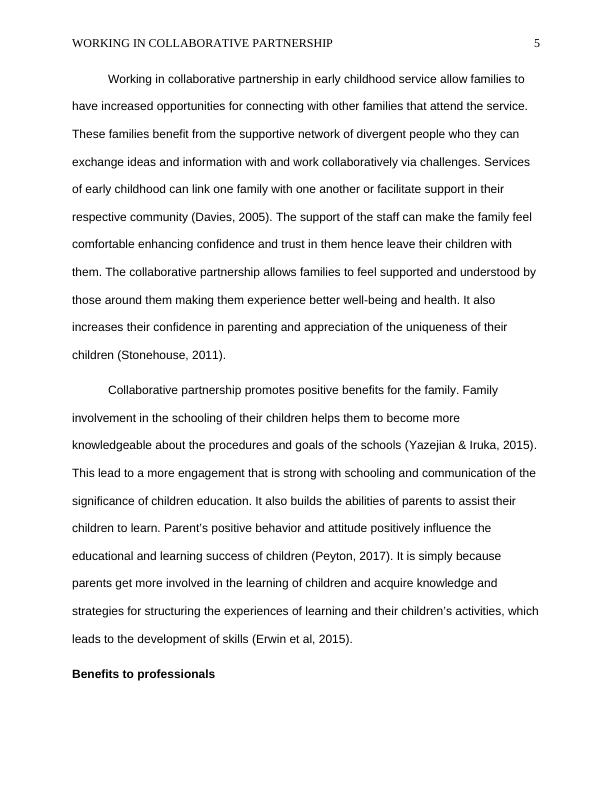
WORKING IN COLLABORATIVE PARTNERSHIP 6
Sharing of positive bonds between the staff and families of children allow the
staff to feel more connected, appreciated, rewarded and valued. Working in a
collaborative partnership enable the staff to respond to the need of young children more
easily by comprehending the relationship of the child with their siblings, carers, and
parents (Sheridan, Edwards, Marvin & Knoche, 2009). It also allows the staff to develop
a deeper comprehension of how each family wishes their child raised. It allows the staff
to have a broader picture of the world surrounding the child, which allows the staff to
associate with young children in a manner that makes them feel comprehended thus
strengthening relationships (Peyton, 2017). The collaborative partnership further helps
the staff to feel satisfied and confident in their responsibility of supporting the child as
well as their development.
Positive Effects
Working in collaborative partnership allow the staff and families to communicate
openly and trust one another. Sharing of information allow the staff and the families to
gain a deeper comprehension of the ways that are most effective to support the learning
of young children (Sanders & Munford, 2010). It also promotes the understanding of the
resources for addressing the challenges of children, how to collaboratively work
together with the aim of supporting children and the behaviors of children while at home
at the services of early childhood. The interaction of collaborative partnership assists
the staff and families to perceive things from differently, develop connections that are
strong with young children and benefit from the shared process of decision-making
(Sheldan et al., 2009). It also assists them to feel, valued, respected, welcomed,
supported in their roles, confident and comfortable. Furthermore, it makes them feel
Sharing of positive bonds between the staff and families of children allow the
staff to feel more connected, appreciated, rewarded and valued. Working in a
collaborative partnership enable the staff to respond to the need of young children more
easily by comprehending the relationship of the child with their siblings, carers, and
parents (Sheridan, Edwards, Marvin & Knoche, 2009). It also allows the staff to develop
a deeper comprehension of how each family wishes their child raised. It allows the staff
to have a broader picture of the world surrounding the child, which allows the staff to
associate with young children in a manner that makes them feel comprehended thus
strengthening relationships (Peyton, 2017). The collaborative partnership further helps
the staff to feel satisfied and confident in their responsibility of supporting the child as
well as their development.
Positive Effects
Working in collaborative partnership allow the staff and families to communicate
openly and trust one another. Sharing of information allow the staff and the families to
gain a deeper comprehension of the ways that are most effective to support the learning
of young children (Sanders & Munford, 2010). It also promotes the understanding of the
resources for addressing the challenges of children, how to collaboratively work
together with the aim of supporting children and the behaviors of children while at home
at the services of early childhood. The interaction of collaborative partnership assists
the staff and families to perceive things from differently, develop connections that are
strong with young children and benefit from the shared process of decision-making
(Sheldan et al., 2009). It also assists them to feel, valued, respected, welcomed,
supported in their roles, confident and comfortable. Furthermore, it makes them feel
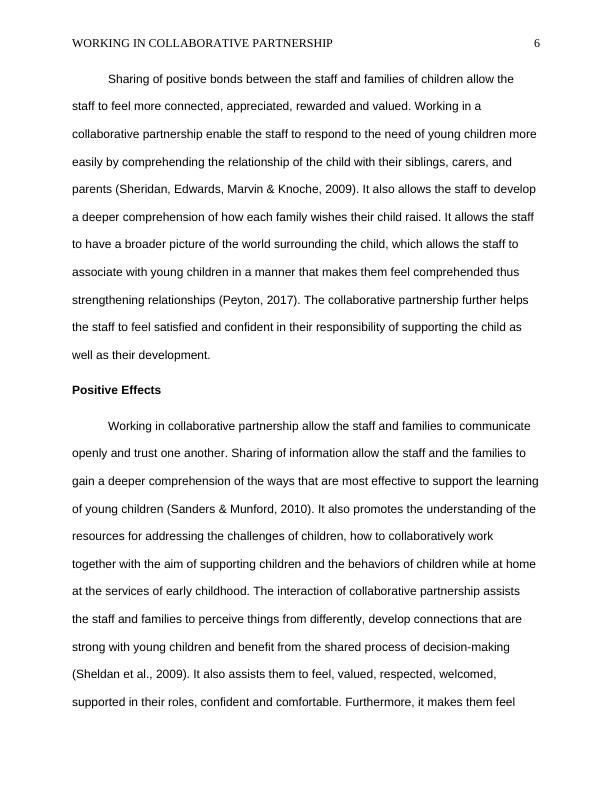
End of preview
Want to access all the pages? Upload your documents or become a member.
Related Documents
Study in Early Childhood Education and Carelg...
|5
|1201
|27
Perspective on Working in Partnership With Familieslg...
|7
|890
|142
Key Elements of Framework's Policy on Parent and Community Partnershipslg...
|6
|977
|151
Transition from Home to Early Childhood Education and Care Settinglg...
|8
|1923
|184
Key elements of the Framework’s policy on parent and community partnershipslg...
|5
|888
|192
Childhood Education Collaborative Partnerships Essay 2022lg...
|10
|3383
|44
